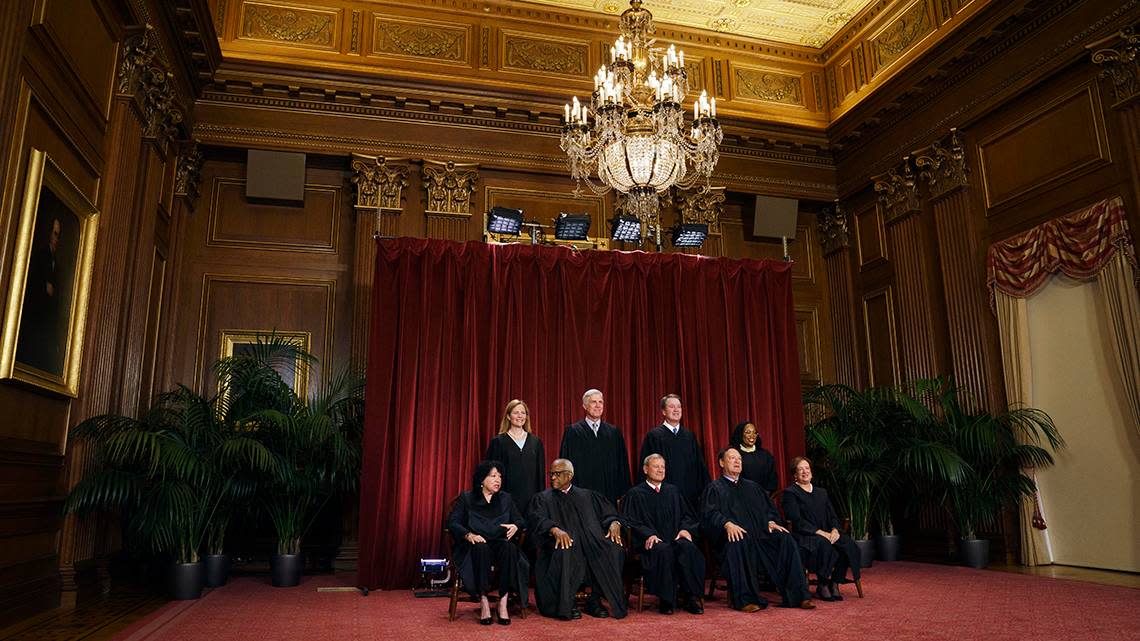It’s undemocratic that we still don’t have term limits for Supreme Court Justices | Opinion
President Joe Biden is right about the desirability of term limits for Supreme Court justices, but he is wrong that it can be done without a constitutional amendment. There is bipartisan support for the idea of term limits, so a constitutional amendment is plausible, but it is enormously difficult to get two-thirds of both houses of Congress and then three-fourths of the states to agree to amend the Constitution.
Before becoming chief justice, John Roberts said, “The Framers adopted life tenure at a time when people simply did not live as long as they do now. A judge insulated from the normal currents of life for 25 or 30 was a rarity then, but is becoming commonplace today.”
Indeed, from 1789 to 1970, the average Supreme Court justice served for 15.2 years. By contrast, justices appointed after 1970 who have since left the bench have served an average of 27.6 years.
Opinion
Clarence Thomas was 43 years old when he was confirmed for the court in 1991. If he remains on it until he is 90 years old, the age at which Justice John Paul Stevens retired, he will be a justice for 47 years. Amy Coney Barrett was 48 years old when she was confirmed, meaning that if she remains on the court until she is 87, the age at which Justice Ruth Bader Ginsburg retired, Barrett will be a justice until the year 2059.
The fact is it’s just too much power in a single person’s hands for too long a period of time.
Also, too much depends on the accident of history as to when vacancies occur. Between 1960 and 2020, there were 32 years with a Republican president and 28 with a Democrat in the White House. But during this time, Republican presidents picked 15 justices, while Democratic presidents selected only eight. For example, President Donald Trump chose three justices in his four years in office, while the prior three Democratic presidents — Jimmy Carter, Bill Clinton and Barack Obama — picked only four justices in a combined 20 years in the White House.
Sign Up for Bee Opinionated
The Sacramento Bee’s opinion team is hard at work sifting through the chaos so you don’t have to. Get our weekly Bee Opinionated newsletter straight to your inbox and we'll help you cut through the drone of the news cycle.
I have long argued for 18-year non-renewable terms for Supreme Court justices. These should be arranged so that there is a vacancy every two years, giving each president equal ability to shape the composition of the court.
Unsurprisingly, there is strong public support for term limits. A 2020 survey found that 77% of people favor term limits for Supreme Court justices. And a recent poll found that 89% of Democrats and 56% of Republicans support a cap on the number of years a justice can serve. During the 2016 Republican presidential primaries, candidates Rick Perry, Mike Huckabee and Ben Carson announced support for Supreme Court term limits.
But term limits for Supreme Court justices would require a constitutional amendment. Article III, section 1 of the Constitution says: “The Judges, both of the supreme and inferior courts, shall hold their offices during good behaviour.” This has been understood to mean that justices as well as all federal judges have their positions for life unless they resign or are impeached and removed.
Some have argued that, notwithstanding this constitutional language and historical practice, Congress could create term limits by statute. Their argument is that justices would keep their title and salary and could sit on courts of appeals and fill in when a justice is recused. But then they are not functioning as a justice in the way it always has been understood — they would be Supreme Court justices in name only.
The central feature of being a Supreme Court justice is participating in the decisions of the court. Taking this away, while preserving the title and salary, cannot be reconciled with the Constitution as it always has been understood.
This does not make term limits impossible, but it means that a constitutional amendment is required to accomplish them. The process of amending the Constitution is daunting, and has been done only 17 times since 1791.
The bipartisan support for term limits makes an amendment possible. The problem is that Republicans would surely oppose an amendment that created term limits for current justices. But term limits that would apply only prospectively will not make a difference for a long time to come. On the current court, six justices are under the age of 70: John Roberts, 69; Elena Kagan, 64; Brett Kavanaugh, 59; Neil Gorsuch, 57; Ketanji Brown Jackson, 54; and Amy Coney Barrett, 52.
But the perfect should not be the enemy of the good. Work should begin immediately on a proposal for a constitutional amendment for term limits that will apply to every new justice.
Erwin Chemerinsky is dean and professor of law at the UC Berkeley School of Law.







